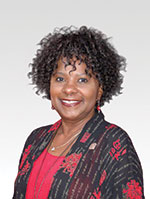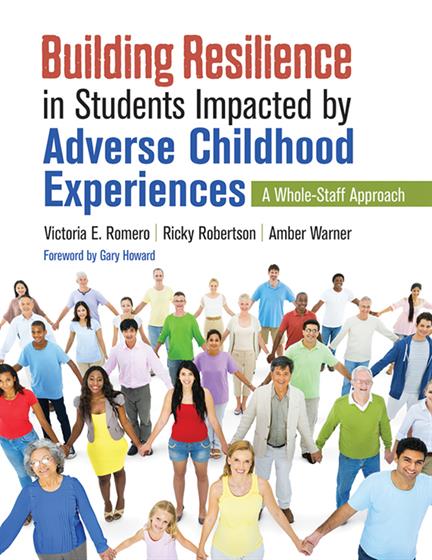
Hands-on, Practical Guidance for Educators
From math,
literacy, equity, multilingual learners, and SEL, to assessment, school counseling,
and education leadership, our books are research-based and authored by experts
on topics most relevant to what educators are facing today.
Building Resilience in Students Impacted by Adverse Childhood Experiences
Foreword by Gary R. Howard
Discover how to make a whole-school change to establish a healthy social-emotional climate for students impacted by adverse childhood experiences and the staff who support them.
- Grade Level: PreK-12
- ISBN: 9781544319414
- Published By: Corwin
- Year: 2018
- Page Count: 248
- Publication date: May 30, 2018
Review Copies
Review copies may be requested by individuals planning to purchase 10 or more copies for a team or considering a book for adoption in a higher ed course. To request a review copy, contact sales@corwin.com.
Description
Use trauma-informed strategies to give students the skills and support they need to succeed in school and life
Nearly half of all children have been exposed to at least one adverse childhood experience (ACE), such as poverty, divorce, neglect, homelessness, substance abuse, domestic violence, or parent incarceration. These students often enter school with behaviors that don’t blend well with the typical school environment. How can a school community come together and work as a whole to establish a healthy social-emotional climate for students and the staff who support them?
This workbook-style resource shows K-12 educators how to make a whole-school change, where strategies are integrated from curb to classroom. Readers will learn how to integrate trauma-informed strategies into daily instructional practice through expanded focus on:
- The different experiences and unique challenges of students impacted by ACEs in urban, suburban, and rural schools, including suicidal tendencies, cyberbullying, and drugs
- Behavior as a form of communication and how to explicitly teach new behaviors
- How to mitigate trauma and build innate resiliency through a read, reflect, and respond model
Let this book be the tool that helps your teams move students away from the school-to-prison pipeline and toward a life rich with educational and career choices.
“I cannot think of a book more needed than this one. It gives us the tools to support our students who have the most need while practicing the self-care necessary to continue to serve them.”
—Lydia Adegbola, Chair of English Department
New Rochelle High School, NY
“This book highlights the impact of trauma on children and the adults who work with them, while providing relevant and practical strategies to understand and address it through reflective practices.”
—Marine Avagyan, Director, Curriculum and Instruction
Saugus Union School District, Sunland, CA
Transform your school with trauma-informed strategies for teacher and student well-being. Learn more about consulting.
Author(s)

Victoria E. Romero

Ricky Robertson
Ricky Robertson is an educator, author, and consultant. He has had the privilege to work with students from pre-K to 12th grade who have persevered in the face of adversity and trauma. He began his career in education as a New York City public high school teacher, teaching in one of the city’s highest-performing public schools. He then went on to work as a teacher, behavior specialist, and, eventually, as an administrator in traditional and alternative schools supporting students with significant mental health and behavioral needs.
Ricky is the co-author, along with Victoria Romero and Amber Warner, of the Corwin bestselling book, Building Resilience in Students Impacted by Adverse Childhood Experiences: A Whole Staff Approach. The model that he and his co-authors developed in their book was included in the Roadmap for Resilience: The California Surgeon General’s Report on Adverse Childhood Experiences, Toxic Stress, & Health as an example of best practices for schools to support children and families impacted by toxic stress and trauma. Ricky continues to work with state and federal policymakers as an adviser on trauma-informed care in public health and education policy.
As a consultant and coach, Ricky works with schools, school districts, education service districts, and state departments of education across the country to develop systems of support that foster achievement, well-being, and resilience among staff and students. His work has been featured in podcasts, online media, books, magazines, national conferences, as well as a trauma-informed teaching video series developed by the National Education Association, WETA, and AdLit.
Ricky finds inspiration in the resilience of young people and the heart and hard work of educators.

Amber N. Warner
Amber N. Warner is a Licensed Clinical Social Worker, with over 20 years of experience. She has had the privilege of serving as a community outreach case manager (4 years), school social worker (8 years), medical social worker (5 years) , and behavioral health therapist (3 years). As a School Social Worker, in addition to her work with children and their families, she was part of the school wide Modern Red School House Leadership Team and the Positive Behavior Interventions and Systems Team. She facilitated K-6 monthly classroom discussions utilizing Second Step and Character Counts curriculums. Amber is also a co-author of Building Resilience in Students Impacted by Adverse Childhood Experiences: A Whole Staff Approach.
In 2011 Amber worked in healthcare and part of the organization’s leadership team, she was introduced to the work of Dr. Bryan Sexton on healthcare providers’ staggering burnout rates and the healing proponents of Positive Psychology. A new passion and interest developed for her. She became a Certified Duke Patient Safety Officer in 2013 at Duke University’s Patient Safety Center.
Amber has also studied under the direction of Dr. David Burns, leading Psychiatrist, and adjunct professor at Stanford University and the developer of TEAM a new form of Cognitive Behavioral Therapy for the treatment of depression and anxiety. She has achieved Level 2 TEAM certification from the Feeling Good Institute.
She has a certification from the National Clearinghouse on Families and Youth in Trauma-Informed Care.
Most of all, Amber has a passion for people, their wellness, and quality of life. She currently resides in California. She enjoys spending time with family and friends, hiking, Inferno Pilates, learning new things, traveling, community service, attending church, and an occasional new pair of shoes.
Table of Contents
Foreword by Gary R. Howard
Preface
Acknowledgments
About the Authors
Chapter 1 ACEs and the New Normal
ACEs Are an Equal Opportunity Occurrence
Lost in Translation
The New Normal
Chapter 2 Put on Your Own Oxygen Mask Before Helping Others
Burnout or Compassion Fatigue?
The New Normal: A Case Study Intervention
Self-Care Is an Ethical Imperative
WWAD?
Chapter 3 It’s Easy to Have High Expectations—Hard to Grow a New Mindset
Knowing Myself Precedes Teaching Students
Knowing My Students and Knowing Pedagogy-Growing Mindset
Knowing My Strengths, Knowing the Strengths of My Students Fosters Resiliency
“I Can’t Learn From You Because You’re White”
Progress Not Perfection
Knowing Myself and Responding to Change Are About Self-Care
Knowing Myself Matters—Because When Negative Bias Shows Up, Students Are Miseducated
Good Teaching Is Not Enough—The New Normal Warrants Transformationist Teaching
Chapter 4 The Effects of Trauma on the Brain
Acknowledging That Trauma Is Sitting in the Classroom Is Transformational Teaching
ACEs and Learning
ACEs and Behavior
Trauma Has Many Forms
If I Knew Then What I Know Now
Chapter 5 Teaching Behaviors, Differentiating Interventions, Changing Pedagogy
Relationships Precede Learning
Talk, Trust, Feel, Repair
Schools and Classrooms Have a Culture and Culture Is Learned
Response to Intervention (RTI)
Looking at Behavior Management Through a Trauma-Informed Lens
Change Is Hard and Leadership Matters
Talk, Trust, Feel, Repair: My Rookie Year
Schools Are Ideal for Social Working
Chapter 6 Plan With the End in Mind: Visioning a Compassionate School
The Innovative School District PreK–12th Grades
SEL Data Team/Self-Assessment Checklist
Case Study: ISD’s Response to Behavior Interventions
Changing Positions to Change Lives
What Does It Mean to Work in a Trauma-Informed School or School District?
Chapter 7 From Theory to Practice: Transformationist Actions Convert ACEs to Aces
Transformationist Schools and School Districts
Transformationist Instructional Staff
Transformationist School Counselors and School-Based Social Workers
Transformationist School Psychologists and School Nurses
Transformationist Support Staff (Office, Cafeteria, Custodial, Bus Drivers)
Chapter 8 The Process, the Plan, the Transformation
The Process
Step 1: Assessing Capacity
Step 2: Building Capacity
Step 3: Implementation
Step 4: Evaluating Program Effectiveness
Where Is Our Sense of Urgency?
The Plan: Implementation Guide to Transformation
Implementation
Evaluation and Planning
Chapter 9 In Their Own Words
Antwone Fisher
Cleressa Brown
Conor Black
Maria Gonzales
The Salomon Martinez Family
Additional Reading and Resources
Glossary of Terms
References
Index
Reviews
"I cannot think of a book as needed as this one. It provides educators with a deeper understanding of the impact of childhood trauma on the educational experiences of young people, and it also gives us tools to support our students who have the most need while practicing necessary self-care to continue to serve them."
Lydia Adegbola"I cannot think of a book as needed as this one. It provides educators with a deeper understanding of the impact of childhood trauma on the educational experiences of young people, and it also gives us tools to support our students who have the most need while practicing necessary self-care to continue to serve them."
New Rochelle High School, NY
“How many times has an educator flown on a plane and been reminded to first put on his or her own oxygen mask before assisting others? As many times as we have heard this directive, we may not have reflected upon its importance to us. This book provides a wealth of research, resources, and tools to assist any school or district in accomplishing its mission to reach all students and to recognize the impact that ACEs have, first upon the student, but also upon the educator who is likely dealing with the ‘fallout’ of each student’s experiences. Never have I seen such a comprehensive book that provides both research and potential solutions in the form of systems and approaches. This is a must read for all educators!”
Lynn Lisy-Macan“How many times has an educator flown on a plane and been reminded to first put on his or her own oxygen mask before assisting others? As many times as we have heard this directive, we may not have reflected upon its importance to us. This book provides a wealth of research, resources, and tools to assist any school or district in accomplishing its mission to reach all students and to recognize the impact that ACEs have, first upon the student, but also upon the educator who is likely dealing with the ‘fallout’ of each student’s experiences. Never have I seen such a comprehensive book that provides both research and potential solutions in the form of systems and approaches. This is a must read for all educators!”
University at Albany-SUNY
“Adequately covering the content is one thing, but actually relating the material to all of us who work in education by providing stories makes this book even more meaningful and powerful. Whether you are a superintendent or a custodian, Building Resilience in Children Impacted by Adverse Childhood Experiences is impactful and will change the way you view ACEs.”
Dustin Johnson“Adequately covering the content is one thing, but actually relating the material to all of us who work in education by providing stories makes this book even more meaningful and powerful. Whether you are a superintendent or a custodian, Building Resilience in Children Impacted by Adverse Childhood Experiences is impactful and will change the way you view ACEs.”
High Point University
“This entire book helps readers understand that kids may not be victims, but they are equally traumatized when they see things happening to those around them. It demonstrates that second-hand trauma does indeed exist. It goes a step further and has the reader analyze how he or she would react and how to go about creating a plan of action and then reviewing the plan. How can we go any further if we don’t look at our interventions? This is a practical book that educators needed yesterday. Using it equips school counselors, nurses, social workers, and teachers with the knowledge and tools to help children through trauma.”
Delsia Malone“This entire book helps readers understand that kids may not be victims, but they are equally traumatized when they see things happening to those around them. It demonstrates that second-hand trauma does indeed exist. It goes a step further and has the reader analyze how he or she would react and how to go about creating a plan of action and then reviewing the plan. How can we go any further if we don’t look at our interventions? This is a practical book that educators needed yesterday. Using it equips school counselors, nurses, social workers, and teachers with the knowledge and tools to help children through trauma.”
AL Department of Early Childhood Education
“This book is very important and relevant for practitioners. This is a topic that is so important right now—there are many children who struggle because of early traumatic experiences and act out in the classroom—and there are few resources to help a classroom teacher understand and instruct them. This book includes strategies that a school can take to meet these challenges and help to make life and learning better for these students. In a so-called ‘regular classroom’ those challenges are possibly fewer in number, but they are still there—students with ACEs are in all classrooms, and the approach advocated by the book’s authors is very useful to teachers.”
Rebecca Rupert“This book is very important and relevant for practitioners. This is a topic that is so important right now—there are many children who struggle because of early traumatic experiences and act out in the classroom—and there are few resources to help a classroom teacher understand and instruct them. This book includes strategies that a school can take to meet these challenges and help to make life and learning better for these students. In a so-called ‘regular classroom’ those challenges are possibly fewer in number, but they are still there—students with ACEs are in all classrooms, and the approach advocated by the book’s authors is very useful to teachers.”
Monroe County Community School Corporation, Bloomington, IN
“This book addresses a critical area of need in today’s society, which spills over into our classrooms and schools. It highlights the impact of trauma on children and the adults who work with them, while providing relevant and practical strategies to understand and address it through reflective practices. Thank you for this important work! Every educator must read this book!”
Marine Avagyan“This book addresses a critical area of need in today’s society, which spills over into our classrooms and schools. It highlights the impact of trauma on children and the adults who work with them, while providing relevant and practical strategies to understand and address it through reflective practices. Thank you for this important work! Every educator must read this book!”
Saugus Union School District, Sunland, CA
"For TESOL professionals, who often find themselves on the forefront of the “new normal” and are the closest to students whose behavior may express how they feel better than their limited English ability can, this book, with the transformational pedagogy it represents, is indispensable."NYS TESOL Journal
Other Titles in: Teaching Strategies for Diverse Students | Teaching At-Risk Students | At-Risk/Troubled Students
Review Copies
Review copies may be requested by individuals planning to purchase 10 or more copies for a team or considering a book for adoption in a higher ed course. To request a review copy, contact sales@corwin.com.
Related Professional Learning
Related WebinarsRelated Resources
- Building Resilience in "The New Normal" [Blog]
- The Role of the School Social Worker [Podcast]
- The Trauma of Teaching [Blog]

